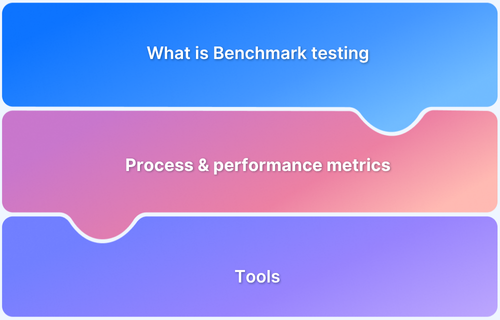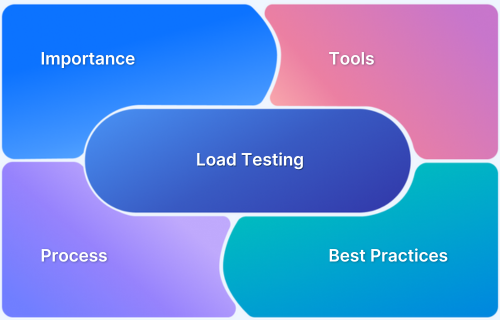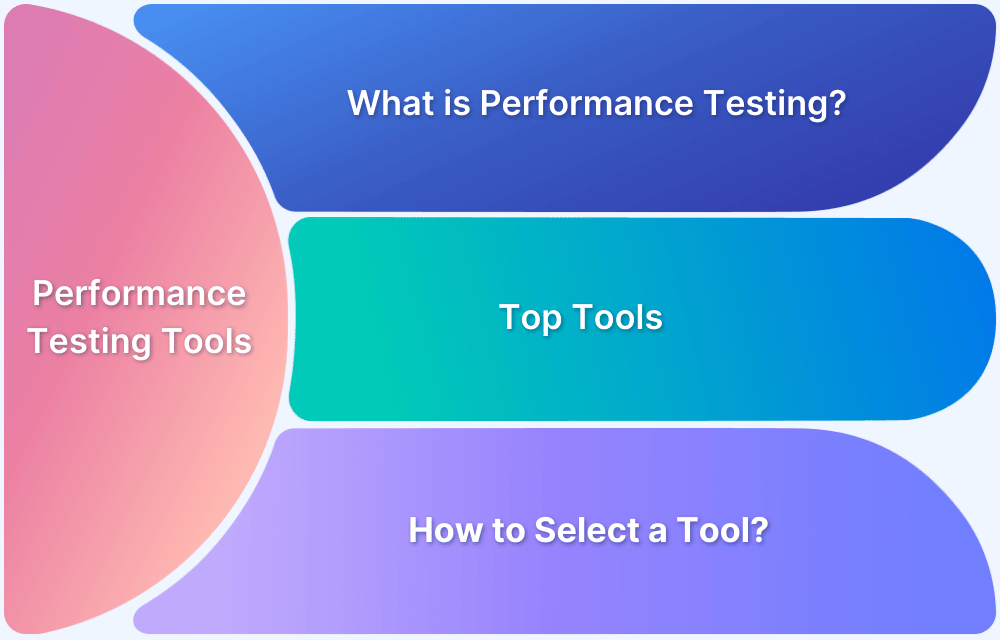Performance testing ensures reliability, speed, and stability under varying conditions, but its effectiveness depends on having clear, well-defined goals.
Overview
What is Performance Testing?
Performance testing is a software testing method used to evaluate how well an application performs under specific conditions.
Goals of Performance Testing
- Ensure stability: Verify app remains stable under normal and peak loads.
- Identify scaling needs: Pinpoint when and how to scale infrastructure.
- Optimize speed: Improve response times for better performance.
- Find bottlenecks: Detect slow queries, memory leaks, or code issues.
- Benchmark performance: Set baselines for future comparison.
- Ensure reliability: Confirm system handles traffic consistently.
- Enhance user experience: Deliver smooth, fast interactions at all times.
How to Define Performance Testing Goals
- Identify key metrics like response time, throughput, and resource usage.
- Set measurable targets for each metric to define success clearly.
- Involve stakeholders to align goals with technical and business needs.
- Analyze real user behavior to base goals on actual usage patterns.
- Design realistic test scenarios that simulate real-world conditions.
- Run tests to establish baselines for future comparisons and tracking.
- Review and refine goals based on test results and evolving requirements.
This article explores performance testing’s key goals, their importance, and best practices for effectively achieving them.
What is Performance Testing?
Performance testing is a type of software testing that evaluates how well an application performs under specific workloads. It focuses on assessing the speed, responsiveness, scalability, stability, and resource usage of a system to ensure it meets both user expectations and business requirements.
Unlike functional testing, which verifies what the system does, performance testing determines how efficiently it does it.
The primary goal of performance testing is to identify and eliminate performance bottlenecks that could impact user experience or system reliability. It helps developers and operations teams understand the system’s behavior under normal, peak, and stress conditions.
Performance testing is not limited to measuring load capacity, it also examines how the system responds to sudden spikes in usage, whether it can sustain heavy loads over extended periods, and how effectively it scales when additional resources are introduced.
Role of Performance Testing in Software Development
Performance testing plays a critical role across the software development lifecycle.
- Ensures the system is fast, stable, and scalable under different load conditions.
- Identifies performance issues like slow response times, crashes, and high resource usage early in development.
- Helps maintain consistent performance across multiple releases in Agile and DevOps workflows.
- Reduces the risk of failure in real-world usage by testing under expected and peak traffic.
- Improves user satisfaction by delivering smooth and responsive experiences.
- Supports business reliability and growth by protecting the application’s performance standards.
- Enables continuous improvement by integrating with CI/CD pipelines for ongoing testing.
Must Read: What is Benchmark testing?
Key Goals of Performance Testing
The primary goals of performance testing are to ensure that an application runs efficiently, remains stable under varying loads, and scales effectively as demand increases. It focuses on assessing how the system behaves under different user conditions to guarantee a consistent and reliable user experience.
Key Objectives of Performance Testing:
- Ensure Optimal Response Time: One of the goals of performance testing is to measure how quickly the system responds to user interactions. Applications must respond within acceptable time limits to provide a smooth and engaging user experience.
- Validate System Throughput: Throughput represents the number of transactions or requests the system can process within a given time. Testing helps ensure the system can handle expected traffic efficiently without slowing down or failing.
- Assess Scalability: Scalability testing determines how effectively the application can handle growth in user load or data volume. This ensures the system can scale up or out as demand increases without performance degradation.
- Monitor Resource Utilization: Performance testing evaluates how efficiently system resources like CPU, memory, network bandwidth, and storage are used. The goal is to maintain balance, avoiding both underutilization and overload.
- Verify Stability and Reliability: Stability testing (often through endurance or soak tests) ensures the system remains consistent and reliable under sustained load for extended periods. It helps detect memory leaks or degradation over time.
- Identify and Eliminate Bottlenecks: By analyzing performance test data, teams can pinpoint slow database queries, inefficient code, or configuration issues that impact performance and address them proactively.
- Ensure Consistent User Experience: Ultimately, performance testing guarantees that users experience fast and reliable service regardless of traffic conditions, location, or device, thereby strengthening trust and satisfaction.
- Evaluate Load Handling Capacity: A crucial aspect of performance testing, load testing measures how the system performs under expected user load. It helps determine the maximum number of concurrent users or transactions the system can support while maintaining acceptable response times and stability. This testing ensures that the system won’t crash or slow down during high-traffic scenarios such as product launches, sales events, or seasonal spikes.
Websites often slow down or crash under heavy traffic, leading to poor user experience and revenue loss. BrowserStack Load Testing helps prevent this by simulating real-world traffic at scale, identifying performance bottlenecks, and ensuring your site stays fast and reliable under peak load.
What is Goal-Based Performance Testing?
Goal-based performance testing is a structured approach in software testing where clear, predefined objectives guide performance tests.
Instead of testing randomly or just to observe system behavior, this method focuses on ensuring the software meets specific performance benchmarks under various conditions.
This approach helps teams focus on what truly matters: meeting user expectations and business requirements related to speed, scalability, and reliability.
Key Steps in Goal-Based Performance Testing
Here are the key steps involved in goal based performance testing:
- Set Performance Goals: Define measurable targets like response time limits, user load capacity or resource usage thresholds.
- Design Realistic Test Scenarios: Based on these goals, create scenarios that simulate real user conditions such as high traffic, peak hours, or heavy transactions.
- Run the Tests: Execute tests and monitor key metrics such as speed, throughput, and system stability under load.
- Analyze and Improve: Compare results against goals. Identify performance issues and optimize the system where needed.
- Repeat the Cycle: Re-test after improvements to confirm goals and catch any new issues.
Also Read: Top 20 Performance Testing Tools in 2025
Importance of Defining Goals in Performance Testing
Defining clear performance goals is the foundation of meaningful performance testing. These goals act as benchmarks to evaluate how well the software performs under different conditions, such as normal usage, peak traffic, or stress scenarios.
Without clear goals, performance testing becomes vague and directionless. With them, testing becomes focused, measurable, and aligned with real-world needs.
Why Defining Goals Matters:
- Sets a Clear Target: Performance goals provide a measurable standard to assess the system’s behavior, like response time, throughput, or server load.
- Aligns with Stakeholder Expectations: Well-defined goals ensure the software meets the needs of users, clients, and business teams, avoiding surprises after deployment.
- Validates Performance Requirements: Goal-based testing confirms whether the application meets performance expectations across different load conditions.
- Improves Resource Efficiency: Tracking how resources are used against specific goals can identify and optimize inefficiencies, saving time and cost.
- Assesses Scalability: Defined goals help test how the system performs as usage grows, ensuring it can handle future demand without failure.
- Reduces Risk: Testing against goals uncovers potential issues early, minimizing the risk of crashes, slowdowns or dissatisfied users in production.
How to Define Performance Testing Goals
Here are the detailed steps on how you can define performance testing goals:
1. Identify Critical Performance Metrics: Select key metrics that reflect the application’s performance. These metrics act as the foundation for all performance evaluations.
- Response time
- Throughput (requests per second)
- Resource usage (CPU, memory)
- Maximum concurrent users supported
2. Set Measurable Targets: Translate each metric into a clear, measurable goal. These benchmarks help determine success or failure in performance tests.
For example:
- Homepage must load within 2 seconds under normal load
- Application should support 500 users simultaneously with no errors
3. Involve Key Stakeholders: Gather input from developers, QA teams, product owners, and business leads. This ensures that goals reflect both technical capabilities and business priorities. Collaboration also helps uncover hidden expectations.
4. Study Real User Behavior: Use analytics data to understand usage patterns, such as peak traffic hours, frequent user actions, and navigation flows. Real user insights lead to more meaningful and accurate performance goals.
5. Create Realistic Test Scenarios: Design performance tests based on observed behavior patterns. Include common use cases, variable load levels, and real-world delays (e.g., think time). This helps simulate how the system would perform under real conditions.
6. Run Tests and Establish Baselines: Execute the designed test scenarios and record the results. Use this data to create performance baselines as reference points for future tests and optimizations.
7. Review and Refine: After initial testing, revisit the defined goals and refine them if needed based on findings, updated features, or changing business demands. This step ensures that performance goals stay relevant over time.
Goals/Objectives of Key Types of Performance Testing
Objectives of different types of Performance Testing include:
- Stress Testing: To test the application’s ability to remain stable and handle failures when pushed beyond normal limits.
- Soak Testing (Endurance Testing): To confirm that the system can handle continuous usage over a long period without slowdowns or resource leaks.
- Spike Testing: To observe how the system responds to sudden and unpredictable surges or drops in user traffic.
- Scalability Testing: To evaluate how well the system grows in capacity, supporting more users or data without affecting performance.
- Volume Testing: To determine how the application handles large volumes of data and identify when performance begins to decline.
- Capacity Testing: This is to determine the maximum number of users or operations the system can support before reaching its limit.
- Configuration Testing: To test how performance varies across different hardware, software, or network settings and find the best combination.
- Load Testing: To check if the current system setup can handle expected user loads while maintaining smooth performance.
Performance Testing Success Metrics
Key metrics to measure performance testing success include:
- Throughput: Measures how many transactions or data units the system processes per second. Higher throughput indicates better performance.
- Memory Usage: Tracks the amount of memory consumed during operations. Efficient memory use reflects a well-optimized application.
- Response Time (Latency): The time it takes from sending a request to receiving the first response. Lower response time means faster performance.
- Bandwidth: Refers to the amount of data transferred per second over a network. Sufficient bandwidth supports smooth communication between systems.
- CPU Interrupts per Second: Indicates how often the CPU is interrupted to handle tasks. A high rate may signal resource contention or inefficiency.
- Average Latency (Wait Time): The typical delay before receiving a response. Ideal systems aim for minimal wait time.
- Average Load Time: Measures how long it takes, on average, to load each request. Consistently fast load times reflect strong user experience.
- Peak Response Time: Shows the slowest response recorded during the test. It highlights worst-case scenarios for system speed.
- Error Rate: The percentage of failed requests out of total requests made. A low error rate indicates higher reliability.
- Disk Time: This measures how long it takes the system to read from or write to the disk. Slower disk times may indicate I/O bottlenecks.
- Concurrent Users Supported: This tracker shows how many active users can run simultaneously. Higher capacity supports more users without performance drops.
Elevate Your Website’s Performance with BrowserStack
Websites often struggle with performance issues during traffic surges, resulting in slow load times, downtime, and frustrated users.
BrowserStack Load Testing offers a cloud-based solution that helps teams test, analyze, and optimize website performance with exceptional accuracy and scalability.
Why Choose BrowserStack for Load Testing?
- Simulate real-world traffic: Create thousands of virtual users across global locations, without complex infrastructure setup.
- Unified performance insights: Monitor both frontend and backend metrics from a single dashboard to detect and resolve issues early.
- Seamless CI/CD integration: Easily plug into your existing pipelines to run browser and API load tests, catching performance regressions before release.
BrowserStack Load Testing helps ensure your website performs reliably under any traffic condition. By replicating real-world usage at scale and providing end-to-end performance visibility, BrowserStack empowers teams to deliver fast, stable, and high-performing digital experiences.
Best Practices to Achieve Performance Testing Goals
Achieving performance testing goals requires a structured approach, realistic test conditions and continuous improvement.
Here are some key best practices that can help you achieve performance testing goals:
- Define target response times, throughput, and error thresholds aligned with technical and user expectations.
- Integrate performance testing into development from the beginning and throughout the release cycle to catch issues early.
- For accurate insights, base test cases on real user behavior, peak loads, and usage patterns.
- Mirror hardware, configurations, and network conditions to catch environment-specific issues.
- Monitor response time, CPU/memory usage, error rate, and throughput to identify bottlenecks and stability risks.
- Combine load, stress, spike, soak, and scalability tests for a complete performance profile.
- Use automation for repeatable tests and integrate with CI/CD for faster, reliable feedback loops.
- Establish baselines, analyze results, fix issues, and retest to ensure performance improvements.
Conclusion
Performance testing is more than just tracking numbers. It’s about delivering consistent, reliable, and smooth user experiences. Setting clear performance goals ensures that testing efforts stay focused and results are meaningful.
When combined with accurate metrics and real-world test environments, such as those offered by tools like BrowserStack, these goals help development teams build applications that perform confidently under any condition.
Ultimately, goal-driven performance testing leads to better quality, faster releases and greater user satisfaction.






